The Cenozoic history of South America faunas mainly rests on the evidence yielded by the study of fossil mammals. Following the seminal work of William D. Matthew, George G. Simpson established the slogan "Splendid Isolation" for describing the evolutionary history of South American faunas. He envisaged South America (as well as other Southern Hemisphere landmasses) as dead ends in the evolution and geographical expansion of animals and plants that since the Mesozoic come in successive migratory waves from the North.
More than 40 years passed away from the last important contribution by Simpson (1980). Since then, in spite to the exponential increase in biological, paleontological and geological knowledge, and an incredibly new number of fossils, his scheme remained almost unpolluted and most recent books regarding the palaeobiogeography of South American vertebrates follow this paradigm nearly without criticism.
However, the factthat South America was joined to Africa, Australia, Antarctica and India during most of the Cretaceous, and that it was still connected Australia (via Antarctica) and probably Africa up to the Paleogene, together with the large number of shared biotic components between these landmasses, point in favor of a different paleobiogeographical scenario.
The book aims to demonstrate that during the Paleogene (and most of the Neogene) the nature and evolutionary history of South American vertebrates is by far much more intricate than previously envisaged. As will be shown, new evidence suggests that southern landmasses may have played an important role in the early evolution and radiation of extant mammal clades.
This book is not written to conform with the ideal of a technical manual or a review, and is not carried forward to collect all that has been said before. The main goals are to criticize the current Palaeobiogeographic Model of Vertebrate Settlement of South America, and to propose a new vision based on the evidence provided by the natural world in the last decades.


